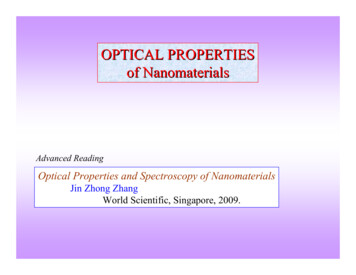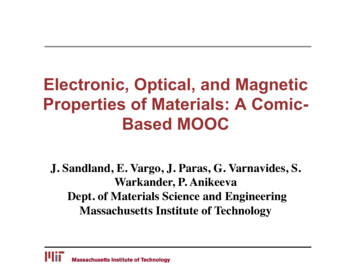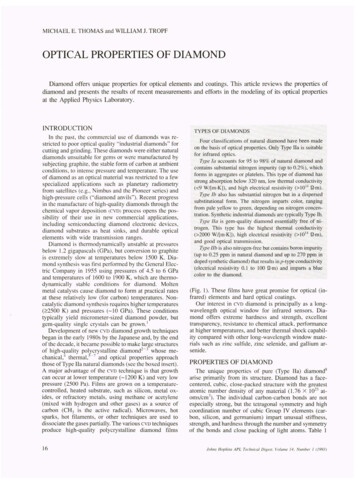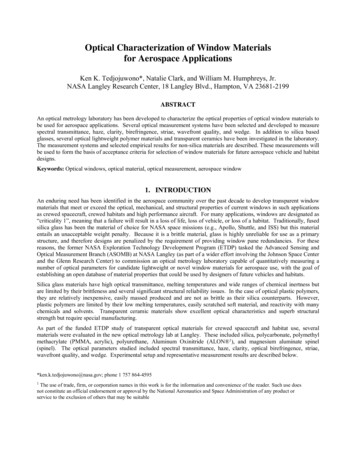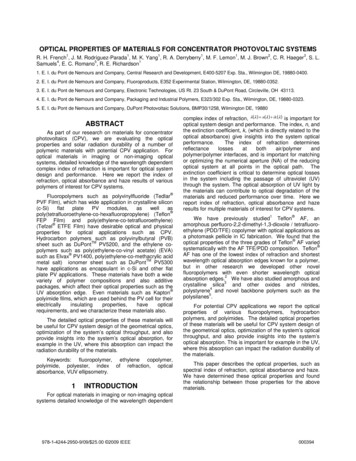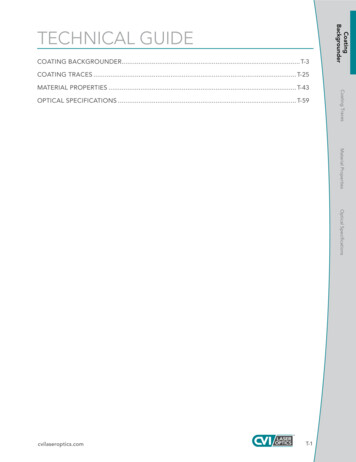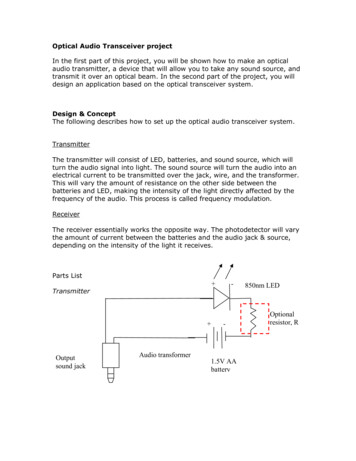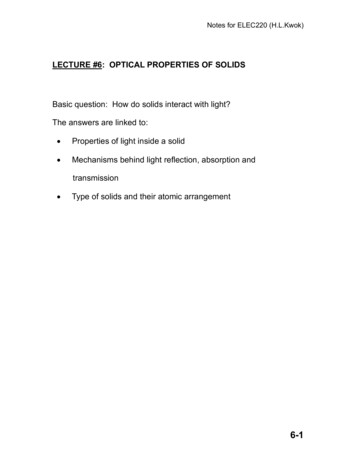
Transcription
Notes for ELEC220 (H.L.Kwok)LECTURE #6: OPTICAL PROPERTIES OF SOLIDSBasic question: How do solids interact with light?The answers are linked to: Properties of light inside a solid Mechanisms behind light reflection, absorption andtransmission Type of solids and their atomic arrangement6-1
Notes for ELEC220 (H.L.Kwok)Light Interaction with SolidsA.Properties of light Light is energy and it has wave propertiesTravels in a straight line but its direction will changeacross different media Light energy E is linked to its wavelength λ throughthe relationship:E hc/λ(28)where h is Planck’s constant ( 0.662 x 10-33 J.s), and c ( 3x 108 m/s) is the speed of light in free-space.6-2
Notes for ELEC220 (H.L.Kwok)Light-solid InteractionsA. Reflection Light energy from one medium passing into anotherwill be partially-reflectedMeasured in terms of a parameter known as thereflectanceReflectance from air into a solid for a lossless media isgiven by:R (η - 1)2/(η 1)2(29)where η is the index of refraction.6-3
Notes for ELEC220 (H.L.Kwok)Quality of the reflected light (at an air-solid interface) Depends on the surface conditions6-4
Notes for ELEC220 (H.L.Kwok) Known as specular reflection if surface is relativelysmooth, and diffuse reflection for a rough surfaceRelative intensity of reflection is measured in a polardiagram - this is a plot of the intensity of reflection Iθ asa function of the angle of incidence θ:Iθ I0 cos(θ)(30)where I0 is the light intensity when θ 0.6-5
Notes for ELEC220 (H.L.Kwok) Brightness is defined as Iθ/Aθ I0 cos(θ)/(A0 cos(θ)) a constant (in viewing)6-6
Notes for ELEC220 (H.L.Kwok)B. TransmissionDepends on the index of refractionLight transmission from one medium into another willchange direction as the velocity of light changes.Difference in the light path is governed by Snell’slaw:η1 sin(θ1) η2 sin (θ2)(31)where η1 and η2 are the refractive indices in the two media,and θ1 and θ2 are the angle of incidence and the angle ofrefraction, respectively.6-7
Notes for ELEC220 (H.L.Kwok)Related terms Transparency is the ability for a solid to transmit a clearimageTranslucency refers to the transmission of a diffusedimage - often the result of scattering by small pores orparticles within the solidOpacity implies a total loss of image transmissionColor of a solid is the result of absorption of a portion ofthe visible light inside the solid - impurities can beadded to a transparent solid to produce specific colors6-8
Notes for ELEC220 (H.L.Kwok)C. AbsorptionRelated to a portion or all of the light energy beingabsorbed by the atoms or ions – energy normally endsup as heat6-9
Notes for ELEC220 (H.L.Kwok) Measured in terms of an absorption coefficientwhich is given by:αa ln(Φ0/Φ(x))/x(32)where x is the distance into the solid, and Φ0 is the lightintensity at the surface (i.e., x 0). Φ(x) will be the lightintensity at position x.6-10
Notes for ELEC220 (H.L.Kwok)Light absorption in semiconductors Results in the generation of electron and holes if thelight energy exceeds the energy gapIncrease in conductivity is known as photoconductivityLight energy involved is often in the visible rangeWhen light energy exceeds energy gap, surfaceabsorption results6-11
Notes for ELEC220 (H.L.Kwok) When light energy is less than energy gap, totaltransmission is observedImpurities present in semiconductors can affect thelight absorption process6-12
Notes for ELEC220 (H.L.Kwok)D. EmissionOccurs when excited atoms/ions return totheir initial (equilibrium) states – this is known asluminescence6-13
Notes for ELEC220 (H.L.Kwok) Occurs when electrons and holes recombine in asemiconductor – this is known as radiativerecombination6-14
Notes for ELEC220 (H.L.Kwok) Very energetic light can cause electron emission from ametal surface - this is known as photoemission6-15
Notes for ELEC220 (H.L.Kwok) All materials at a finite temperature would emit light(black-body radiation)6-16
Notes for ELEC220 (H.L.Kwok)ApplicationsA.Cathode-ray tube (CRT) A display device that relies on light generation bybombardment of a phosphor using an energeticelectron beam in a process known ascathodo-luminescence Source of electrons is a metal electrode heated to ahigh temperature (electron gun) - emitted electronsare attracted to a positive electrode behind the CRTscreenElectrons hitting the phosphor on the screenrecombines with the holes there and emit characteristiccolor lightPhosphors are usually a mixture of ZnS and CdSRecombination has a finite time delay to generate apersistence effectElectron beam can be deflected laterally and verticallyby applying voltages to grids placed orthogonally alongthe beam path 6-17
Notes for ELEC220 (H.L.Kwok) B. Same principle applies to TV tubes - red-green-blue(RGB) colors generated using different types ofphosphors25 inch TV, for instance, tube can have 1/4 millionphosphor dotsFlash gogglesControls the passage of light electricallyGoggle uses polarizers in the front and at the backwhich are polarized at right angle to one another, and aPLZT block is placed in between these polarizers –PLZT is a compound of Pb, La, Ti, Zr and O6-18
Notes for ELEC220 (H.L.Kwok) Incident light arrives at goggle (with electric fieldcomponent polarized at 45 o to the right of the vertical)passes though but are reflected at the back polarizer ifPLZT is inactive6-19
Notes for ELEC220 (H.L.Kwok) Voltage applied to the PLZT is able to rotate thelight - when the polarization angle reaches 90 o, lighttransmission occurs6-20
Notes for ELEC220 (H.L.Kwok) C. Maximum light output is normally limited to about20%Used as an automatic light dimmerLiquid crystal displayLiquid crystal is a suspension of rod-like organicmolecules that can have different forms of orderedstructuresDifferent forms of ordered structure affect theoptical properties of the liquid crystals by changing theindex of refractionIn the natural state, liquid crystal is transparent tolightIn devices light polarization is used controltransmission and reflectionPower used to drive the device is capacitive andconsumption is lowDevice has relatively low resolution and low speedDifferent phases of liquid crystalsa) nematic phase (NP) - molecules are randomlyplaced but are parallel to one anotherb) cholesteric phase (CP) - molecules are parallel inevery plane but are twisted from plane to planec) smectic phase (SP) - molecules are parallel to oneanother and are arranged in layers6-21
Notes for ELEC220 (H.L.Kwok)6-22
Notes for ELEC220 (H.L.Kwok)Construction of a liquid crystal capsule Consists of sheets of glass electrodes and polarizers, aliquid crystal capsule and a back reflector6-23
Notes for ELEC220 (H.L.Kwok) Glass electrodes are covered on the inside with alined polymer pattern - the line pattern on the front andthe back electrodes are 90 o off, forcing the liquidcrystals (in the CP phase) inside the capsule to havethe same twist Polarized light entering the capsule will experience a90 o phase shift when it passes through the lowerpolarizer6-24
Notes for ELEC220 (H.L.Kwok) Reflector reflects the incident light and the reflectedlight undergoes the same phase shift resulting in a“light” pattern emerging from the capsule surfaceElectric field applied across the capsule canturn the CP phase into the NP phase and the light pathis now blocked - this forms the “dark” patternLiquid crystal relies on “light” and “dark” patterns toform imagesMost digital displays use an alpha-numeric patternwhich has 7 segments6-25
Notes for ELEC220 (H.L.Kwok)Example 6.1: What are the energies of light with wavelengths equal to: a) 400nm, and b) 800 nm? What are their colors?Solution:The photon energy is: Ephoton hc/λL 6.63 x 10-34 J.s x 3 x 108 m/s/(1.6 x 10-19C x λL ) 1.24 eV/λL.a) When λL 400 nm or 0.4 µm, Ephoton 3.1 eV (blue).b) When λL 800 nm or 0.8 µm, Ephoton 1.55 eV (red).Example 6.2: What is the number of photons per unit time emerging from asolid if the power output (of the photons) is 10 W and the (average) wavelength is0.65 µm.Solution:Similar to Example 6.1, the photon energy at the wavelength of 0.65 µm is 1.9eV. The number of photons emerging per unit time in an output of 10 W 10W/(1.9 eV x 1.6 x 10-19 V/eV) 0.33 x 1020 photons/s.Example 6.3: When light passes from a medium with a high index of refractionto one with a lower value, total reflection occurs at the critical angle θcr.Compute the critical angle for light transmission from glass to air. Assumeηs(glass) 1.46.Solution:Based on Snell’s law: sin(θglass) sin(θair)/ηs(glass). Since sin(θair) 1 andηs(glass) 1.46, θglass sin-1(1/1.46) 43.3o.Example 6.4: Compare R*, the reflectance in silica glass (ηs 1.46) to that inpure PbO (ηs 2.60). Explain briefly why ornamental glassware has a smallpercentage of PbO present.Solution:6-26
Notes for ELEC220 (H.L.Kwok)Based on the reflectance formula: R* (glass) (1.46 - 1)2/(1.46 1)2 0.035.Similarly, R* (PbO) (2.60 - 1)2/(2.60 1)2 0.198. PbO is therefore morereflective, which gives the ornamental value.Example 6.5: Green light at a wavelength of 0.5 µm is allowed to shine on apiece of silicon. Estimate the distance inside the silicon when the light intensity isdropped by a factor of 100 (see Fig.E4.2).6-27
Notes for ELEC220 (H.L.Kwok)Solution:From Fig.E4.2, α* is 9 x 103 /cm when the wavelength is 0.5 µm. The distancewhen the light intensity is dropped by 100 is x ln(φLo/φ)/α* ln(100)/(9 x 103/cm) 5.1 x 10-4 cm.Example 6.6: A silicon sample has a thickness of 100 µm and a conductivity of10 S/m. If we assume that light is absorbed primarily within 2 µm from thesurface and gives a photoconductivity of 1000 S/m, estimate the fractionalchange in the sample conductivity if the measurement is made along thesemiconductor surface. Ignore any change in conductivity beyond the surfacelayer.Solution:The lateral conductivity of the sample will be the parallel combination of theconductivity of the surface layer and that of the rest of the silicon sample. Thefractional change is: (σ1t1 σ2t2)/(σ1 x (t1 t2)) (2 µm x 1000 S/m 98 µm x10 S/m)/(100 µm x 10 S/m) 2.98.Example 6.7: If we want to form GaInP crystal with an energy gap of 1.5 eV,what percent of GaP has to be used? For simplicity, we assume that the energygap of GaInP depends linearly on the composition of GaP and InP and that theenergy gaps of GaP and InP are 2.26 eV and 1.35 eV, respectively.Solution: Required energy gap of GaInP is Eg 1.5 eV (y x 2.26 (1 - y) x1.35) eV, where y is the percent of InP. This leads to: y 0.17. The compositionshould be 17% GaP and 83% InP.Example 6.8: InSb is an IR detector and it has an energy gap of 0.17 eV.What is the probability that an electron in the valence band is thermally excitedacross the energy gap at 300K.Solution:Since Eg kT (T 300K), we can assume that the probability of carrier excitationto be: exp(- Eg/(kT)) exp(- 0.17 eV/0.026 eV) 1.4 x 10-3. This suggests that6-28
Notes for ELEC220 (H.L.Kwok)there will be 14 electrons excited from the valence band to the conduction bandper 10,000 electrons (in the valence band).Example 6.9: Suggest why Se thin films are unsuitable for use inelectrophotography of documents with a red background.Solution:Although Se has an absorption threshold near 1.7 eV, the electrophotographysensitivity or photoconductivity threshold may not coincide with the absorptionthreshold. In fact, the photoconductivity threshold in Se is in the green (2.4 eV)and is not sensitive to red or yellow. Reflected red or yellow light from thebackground therefore appears as black, the same as the prints in the document.Example 6.10: Compute the photoconductivity in a p-type photoconductor if thehole lifetime is 50 µs and the length of the photoconductor is 1000 µm. Assumethe average velocity of the holes is 1 x 105 m/s.Solution:The transit time of the photoconductor is τt L/v 1 x 10-3 m/105 m/s 10 ns.The photoconductivity gain is τp/τt 50 x 10-6 s/10-8 s 5000.Example 6.11: If a TV set has 500 x 500 pixels and the sweep frequency is 5Mhz, how long does it take to scan the whole screen once.Solution:There are 500 x 500 pixels or 250,000 pixels. To achieve a sweep frequency of5 Mhz, the maximum time delay per pixel is less than 0.1 µs (twice the samplingrate). For 1/4 million pixels, the total time delay is: 0.25 x 106 x 0.1 x 10-6 s 0.025 s.Example 6.12: What is the minimum number of layers of liquid crystals requiredto give a 90 o twist if the maximum angle between the layers is 12o.Solution:6-29
Notes for ELEC220 (H.L.Kwok)The number of layers required is 90/12 7.5 or 8 (round-off).6-30
optical properties of the liquid crystals by changing the index of refraction In the natural state, liquid crystal is transparent to light In devices light polarization is used control transmission and reflection Power used


